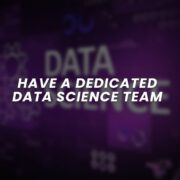Four Steps to Make Your Business Intelligence Teams More Relevant
If we are running a business and have a good reach over the internet, then it’s certain that your business has access to millions of users’ data. Once your business start growing then there will be an unlimited supply of data and utilizing that data is something in which most businesses fail. So, finding a piece of important information from the ocean of data is important for a business owner, so they use a collection of tools named business intelligence. Business intelligence helps users understand the pattern of uses on their platform and it also gives a good idea about what their users are loving the most on their platform so that companies can easily switch focus on that part and improve other aspects of their products.
With access to huge data, the world of analytics is changing, and it has caused the efforts of IT Business Intelligence (BI) teams to gather, clean, and structure data to extract important information, and then perform their own analytics using a self-service model. This can put a lot of pressure on the BI team of your IT organization, so it’s better to have a dedicated team for each step of the process. The most important thing in this is to have a proper reporting of the concepts which will help you in long run and you can easily access the changes happening in the process and results that happened in last few months due to action taken on the part of the projects.
Due to recent changes happening in self-service BI tools it’s a bit difficult for IT business intelligence because these tools can do most of the part a BI team used to do. But the reports generated by a self-service BI tool can be precise but at the same time, it can backfire at some point. So, it’s better to have an expert look after the generated reports and first examine the reports side by side let the tools work on the collected data, and then submit the report to other teams.
Sometimes we need the report on time, but the process needs time to give a precise report on the collected data. So, since we have the problems in hand, and we have a good idea of what we want let’s move towards the solutions we can apply and get the best result.
Have a dedicated Data science team:
 Data scientists are beginning to show up in organizations’ analytical units. They are still not widespread, though, and the position is understaffed. Additionally, most departments inside a corporation are unable to justify hiring a full-time data scientist. You may build a centralized team that can offer analytics to neglected areas of the enterprise by integrating data scientists into the IT BI department. The capacity to extract insights from the data is a natural extension of this team’s current focus on developing analytical data structures and reports.
Data scientists are beginning to show up in organizations’ analytical units. They are still not widespread, though, and the position is understaffed. Additionally, most departments inside a corporation are unable to justify hiring a full-time data scientist. You may build a centralized team that can offer analytics to neglected areas of the enterprise by integrating data scientists into the IT BI department. The capacity to extract insights from the data is a natural extension of this team’s current focus on developing analytical data structures and reports.
Focus on the result:
 Add the capability of Decision Architecture Methodology to your requirements process. The questions used to interpret the data to determine the Dimensions and Facts are the main emphases of most approaches for gathering analytical needs. Although this provides us with excellent descriptive data, it does not advance the business up the analytical maturity curve. The needle will shift if the firm places a stronger emphasis on its decisions and centers its analytical skills on facilitating actionable insights.
Add the capability of Decision Architecture Methodology to your requirements process. The questions used to interpret the data to determine the Dimensions and Facts are the main emphases of most approaches for gathering analytical needs. Although this provides us with excellent descriptive data, it does not advance the business up the analytical maturity curve. The needle will shift if the firm places a stronger emphasis on its decisions and centers its analytical skills on facilitating actionable insights.
Create and add a decision Theory to the Analytical tool
 If Data Science aids in the transformation of data into useful insights, Decision Theory aids in the structuring of the decision-making process to lead a person to the best option. Understanding the elements of the decision process to explain why we make the decisions we do is the focus of decision theory and behavioral economics. It offers a methodical approach to taking attribute tradeoffs into account, which aids in the improvement of our decision-making. Thresholds, alarms, decision matrices, and choice architecture are examples of tools that should be included to your team’s toolkit.
If Data Science aids in the transformation of data into useful insights, Decision Theory aids in the structuring of the decision-making process to lead a person to the best option. Understanding the elements of the decision process to explain why we make the decisions we do is the focus of decision theory and behavioral economics. It offers a methodical approach to taking attribute tradeoffs into account, which aids in the improvement of our decision-making. Thresholds, alarms, decision matrices, and choice architecture are examples of tools that should be included to your team’s toolkit.
Have a proper Report certification:
 For self-service analytics to be used and accepted by a wider audience when report proliferation happens, it will be critical to establishing a standard for the health and validity of a report. As an illustration, you may ask one team to compile a report using important metrics obtained from unreliable data sources. Broader consumers will know the level of scrutiny that has been applied to the report by Data Governance and IT teams and will therefore trust the data and metrics contained therein by putting reports from individual departments through a certification process like UL labeling on electrical products.
For self-service analytics to be used and accepted by a wider audience when report proliferation happens, it will be critical to establishing a standard for the health and validity of a report. As an illustration, you may ask one team to compile a report using important metrics obtained from unreliable data sources. Broader consumers will know the level of scrutiny that has been applied to the report by Data Governance and IT teams and will therefore trust the data and metrics contained therein by putting reports from individual departments through a certification process like UL labeling on electrical products.
Conclusion:
The above-mentioned tips will help you improve your company’s BI teams and help you while creating the proper reports on the given topic. If you cannot afford the dedicated team of data scientists and creating the decision theory or decision-making theory, then it’s best to have the best business intelligence agency to help you and guide you in every aspect of Business intelligence.
At the best Business intelligence agency, they have a dedicated team of BI Experts. They can help you and aid your business to grow.
If you are thinking of getting or contacting any best business intelligence then you can think of contacting Us, we at eComstreet have the experience and expertise of more than a decade now, and our company has a record of satisfied consumers.


